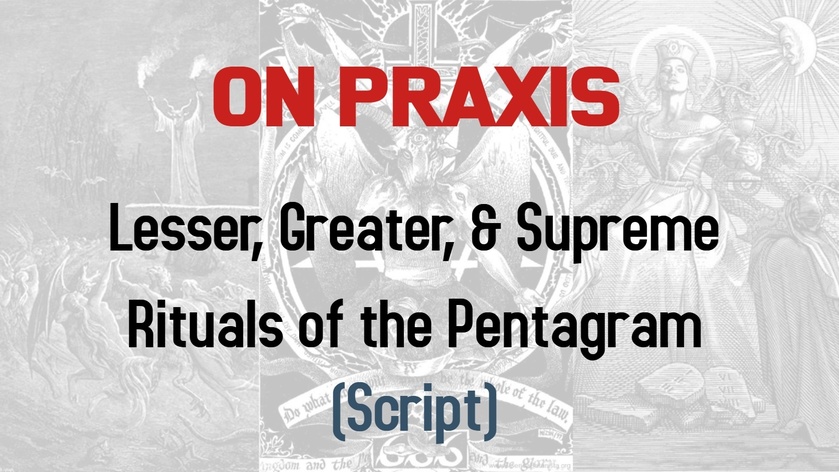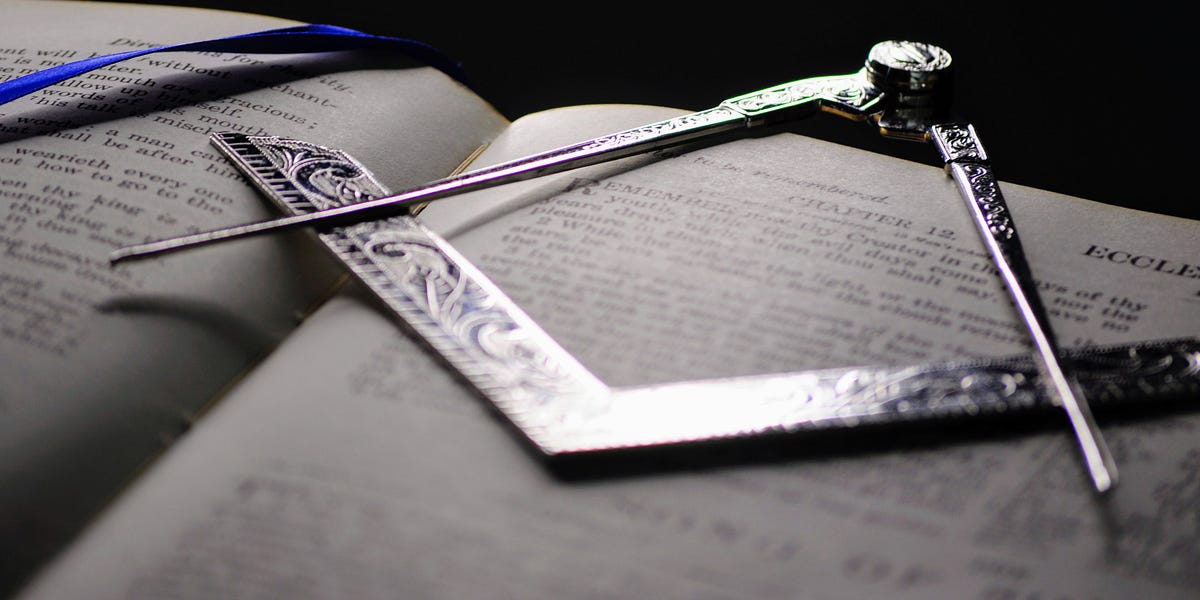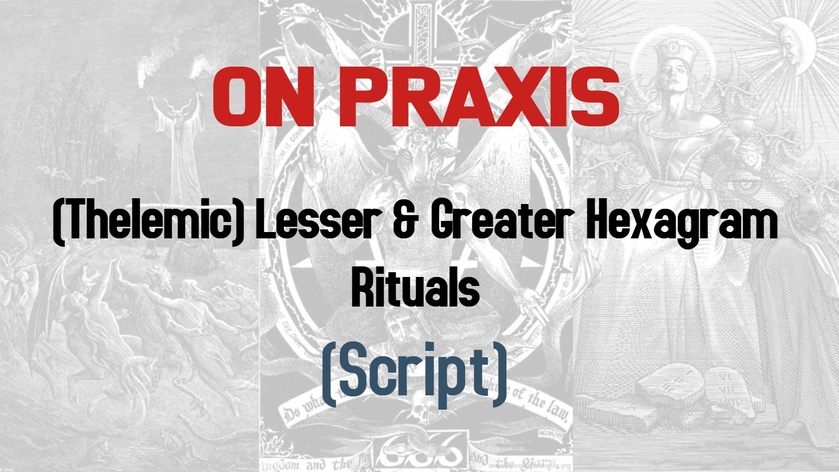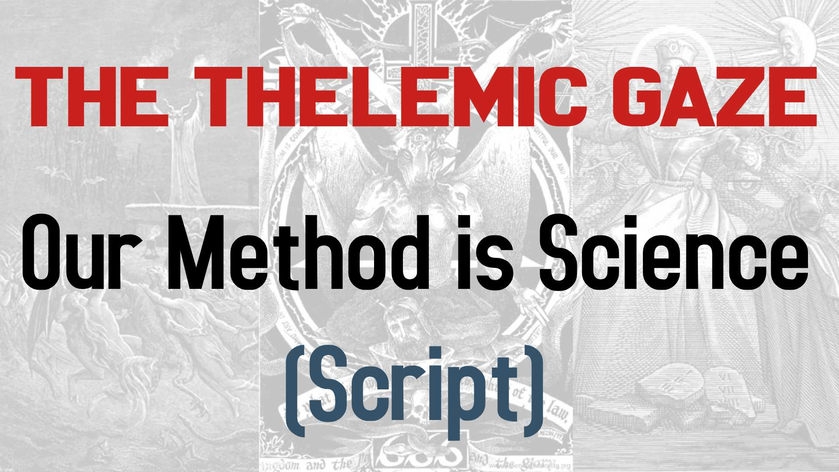
Praxis: Pentagrams: Lesser, Greater, & Supreme
Do what thou wilt shall be the whole of the Law.
Introduction.
In “De Cultu” (Chapter 16 of Liber Aleph vel CXI (111): The Book of Wisdom or Folly), the third instruction reads “Neglect not the Performance of the Ritual of the Pentagram, and of the Assumption of the Form of Hoor-pa-Kraat.”
In order to be a proper Thelemite, according to the words of the founder, one must perform the pentagram ritual and assume the god form of Harpocrates, or the Sign of Silence. The text for the Pentagram Ritual is given in Liber O vel Manus et Sagittae sub figurâ VI (6), section IV (4). Both the Lesser and Greater forms are given. Sadly, the source for the Supreme Pentagram Ritual is still that confusing morass of text that was promulgated by the Golden Dawn. It can be found in Regardie’s book The Golden Dawn, “Volume III, Book Four: Primary Techniques of Magical Practice, and the Magical Weapons”. I have the consolidated paperback of 1990. It is on pages 280-6.
While Liber O is far easier to read, I’ve always found the section on the Greater Ritual of the Pentagram to be confusing. Maybe he felt some lingering attachments to his oaths. He gives step-by-step instructions for the Lesser ritual, but just dumps the Greater variant’s pentagrams and god names for the reader to plug and play. We will start with the Greater variant. We will then discuss the changes wrought to make it the Lesser variant, followed by the Supreme variant.
In the Steven Guth translation of The Book of Abramelin, Book Two, “The end of the second book of Abraham the Jew” (pp 102-3), we are told that Spirits are not impressed by ignorant and mindless repetitions of misunderstood phrases in foreign languages. Far better to speak in one’s native tongue.
Now, the use of an uncommon tongue, e.g., Latin, gives a sense of specialness, of sanctity, to an operation. Abraham instructs his son, who is the target for the book, that when using “holy words in the holy language” to be sure one knows what one is saying. “Always understand what you ask for and write.” Regardless of one’s use of Barbarous Tongues or Holy Language during these rites, be sure that the charge is in clear terms and in one’s own native tongue. We will look at the meanings of the various Hebraic & Enochian phrases before we wrap up.
Basic Format of the Ritual
All rituals of the pentagram, from Lesser to Supreme, follow a fourfold format of Qabalistic Cross, Invocation of the Quarters, a Call to the Archangels, and another Qabalistic Cross to close.
The Thelemic variation of the Pentagram rite is to include the name of one’s Holy Guardian Angel, if known, or Aiwass, if not. This would change the form of the cross from an equal armed cross to more of a Calvary Cross.
The pentagram itself is a five-pointed star drawn with one line. It is typically attributed to the elements. Starting at the lower right we have the active element of Fire. Moving counter-clockwise to the upper right, we have the passive element of Water. The top center point is given to Spirit. On the upper left, we have the active element of Air. Finally, we have the passive element of Earth on the lower left.
The ritual can use up to six variations of the pentagram. They are drawn based upon the elemental attribution of the various points. The invoking pentagrams are drawn toward the element in question. The banishing pentagrams are the exact opposite.
As an example, the invoking pentagram of Air is drawn starting from the point of Water (upper right). One moves across to the point of Air (upper left), down to Fire (lower right), up to Spirit (top), down to Earth (lower left), and back up to Water. I have seen some instruction that had one redraw the initial stroke (in this case, the line from Water to Air). I, personally, do not.
The banishing pentagram is done in the same manner, but the initial stroke is from Air to Water. The initial stroke to invoke Fire would be from Spirit to Fire. To banish would be from Fire to Spirit. Earth would be from Spirit to Earth and from Earth to Spirit. Water is invoked Air to Water and banished with Water to Air.
The pentagrams of Active and Passive Spirit follow a slightly different formula. Active Spirit is designated by connecting the active elements of Fire and Air. Passive Spirit is done by connecting the passive elements of Water and Earth. Invoking is done with an upward motion — Fire to Air or Earth to Water. Banishing is done with a downward motion — Air to Fire or Water to Earth.
There are six titles or names of god, one for each pentagram.
AHIH - Active Spirit;
AGLA - Passive Spirit;
YHVH - Air;
ALHIM - Fire;
AL - Water; and
ADNI - Earth.
We will now move to the actual script for The Thelemic Greater Ritual of the Pentagram. It is characterized by the usage of two pentagrams per quarter and their attendant god-names.
Greater Ritual of the Pentagram
It should be mentioned, that the simple word vibrate indicates a semi-complicated sequence. One inhales, makes the sign of the enterer and vibrates the name, and then makes the Sign of Silence, or Hoor-paar-kraat. I have heard vibrations done in both higher and lower pitches. Having been exposed to Tibetan chanting prior to practicing ceremonial magick, I prefer the lower pitches most times. With that, let us begin with the Greater Pentagram Ritual.
Touching the forehead say Ateh (Unto Thee).
Touching the breast say Aiwass (or the name of your HGA, if known).
Touching the groin say Malkuth (The Kingdom).
Touching the right shoulder, say ve-Geburah (and the Power).
Touching the left shoulder, say ve-Gedulah (and the Glory).
Clasping the hands upon the breast, say le-Olahm, Amen (To the Ages, Amen).
Turning to the East make the pentagram of Active Spirit with the proper weapon (usually the Wand), make the sigil of spirit, and vibrate AHIH. Follow this with the pentagram of Air. Draw the sigil of Aquarius, and vibrate YHVH.
Turning to the South make the pentagram of Active Spirit, make the sigil of spirit, and vibrate AHIH. Follow this with the pentagram of Fire, draw the sigil of Leo, and vibrate ALHIM.
Turning to the West make the pentagram of Passive Spirit, make the sigil of spirit, and vibrate AGLA. Follow this with the pentagram of Water, draw the eagle sigil of Scorpio, and vibrate AL.
Turning to the North make the pentagram of Passive Spirit, make the sigil of spirit, and vibrate AGLA. Follow this with the pentagram of Earth, draw the sigil of Taurus, and say ADNI.
Extending the arms in the form of a Cross say:
Before me Raphael;
Behind me Gabriel;
On my right hand Michael.
On my left hand Auriel;
For about me flames the Pentagram,
And in the Column stands the six-rayed Star.
Repeat (i) to (vi), the Qabalistic Cross.
Comparing the Lesser, Greater, & Supreme Rituals
The Lesser Ritual of the Pentagram is a stripped down version of the Greater. All pentagram variations are reduced to one, the elemental pentagram of Earth without a sigil. Only one pentagram is made per quarter and the god names are compacted. We start with the first god-name, “YHWH,” and skip the intermediaries to the final god-name, “ADNI”. We then follow with the god-names of “AHIH” and “AGLA” for the elements of active and passive spirit, respectively.
The Supreme variation can be viewed as a superset of the Greater. It is little more than the Greater Pentagram Ritual with Enochian. When tracing the lines of the pentagrams, one vibrates the Enochian associated with the pentagrams for that quarter.
As an example, for the Eastern Quadrant, one would draw the pentagram of Active Spirit while vibrating “EXARP.” One would then draw the sigil of spirit and vibrate “AHIH.” Next is to draw the pentagram of Air while Vibrating “ORO IBAH AOZPI.” Finally, one would draw the sigil of Aquarius and vibrate “YHWH.”
The South, or Fire, would use “BITOM,” “AHIH,” “OIP TEAA PDOCE,” and “ALHIM.” To the West, that is, Water, “HCOMA,” “AGLA,” “MPH ARSL GAIOL,” and “AL.” Finally, North, or Earth, is “NANTA,” ”AGLA,” “MOR DIAL HCTGA,” and “ADONAI.” I will append the scripts for All Thelemic Pentagram Rituals to the end of this essay.
It should be noted that the signs of the enterer and of silence are only performed when vibrating the Hebrew. The Enochian is vibrated while making the motion of drawing the respective pentagram.
Translation of Enochian & Hebrew
As you can see, the Supreme ritual has three languages. For this essay we are working with the assumption that English is the native tongue. If one is not a native English speaker, then one should replace these portions with one’s native tongue, whether it is Spanish, Russian, or Japanese.
In addition to the native tongue, we have Hebrew and Enochian. Since the Hebrew is utilized in all three versions, we shall cover it first.
While the Lesser uses four names or titles of god, the Greater and Supreme use six. The Lesser uses the first and last of the titles for the quarters and the two titles associated with invoking spirit. These names, pronunciations and their meanings, are:
AHIH: Eh-Hee-Eh: I am
AGLA: Ah-Glah: which stands for the phrase “Ateh Gibor Le-olam Adonai”, which translates to “You Are Mighty Forever, My Lord.”
YHVH: I have heard various pronunciations; Crowley gives “Ye-ho-wau”, though I prefer “Yah-weh”; some prefer to spell it with “Yod-Heh-Vav-Heh,” but since the actual acronym of AGLA is pronounced as a word, I feel that to spell YHVH is indicative of the operators dislike for Christianity and irrational; YHVH is the Tetragrammaton which represents creation, rebirth, masculine-Feminine, positive-negative, Yin-Yang, and the synthesis/progression of the four elements.
ALHIM: Eh-low-heem: this is a plural used to represent Gods, Goddesses, Angels, and even Great Men.
AL: Ehl: which means Lord God, or Supreme God.
ADNI: Ah-doh-Nie: meaning My Lord, or, in Thelema, My Holy Guardian Angel.
One should note that AGLA contains Adonai, so an alternate reading of “Ateh Gibor Le-olam Adonai” could be “You Are Mighty Forever, My Angel.”
The Enochian follows a similar pattern, seeming to be titles rather than proper names. There are two broad schools of pronunciation. The first is the Golden Dawn method which adds a vowel to the consonants, much like Hebrew. As an example, the Enochian word spelled (in English transliteration) S-O-N-F, would be pronounced “SONuF”. The other, which seems to be supported by the Dee manuscripts, is to pronounce it like it is spelled, “Sonf.” I prefer the latter. I should also point out that I am not an expert on Enochian, so I will not be discussing the system in depth.
In the Supreme Ritual, each quarter has an element, and thus when drawing the pentagram of spirit, either active or passive, for that quadrant one vibrates the Enochian word designating the spiritual form of the element. These are:
EXARP: Air of Spirit
BITOM: Fire of Spirit
HCOMA: Water of Spirit
NANTA: Earth of Spirit
When drawing the elemental pentagrams for each quadrant, likewise vibrate the appropriate phrase. These are, in order:
ORO IBAH AOZPI: You who cry aloud in the place of desolation.
OIP TEAA PDOCE: You whose name is as it ever was.
MPH ARSL GAIOL: You who are the first true creator, the horned one.
MOR DIAL HCTGA: You who burn up iniquity without equal.
Note that each phrase follows the format of three letters, four letters, then five. I have endeavored to make my pronunciation indicative of this structure.
Playtime (Crafting Coherence for Insights)
As a fun exercise, we can craft meaningful phrases from the multiple languages used in each quarter.
EXARP - EHIEH - ORO IBAH AOZPI - YHWH -> Air of Spirit, I am The one who cries aloud from the place of desolation, In the name Tetragrammaton
BITOM - EHIEH - OIP TEAA PDOCE - ELOHIM -> Fire of Spirit, I am the one whose name is as it ever was, by the Gods
HCOMA - AGLA - MPH ARSL GAIOL - EL -> Water of Spirit, who is Mighty Forever, my Angel! You Who Are the First True Creator, the Horned One, O God!
NANTA - AGLA - MOR DIAL HCTGA - ADONAI -> Earth of Spirit, who is Mighty Forever, my Angel! You who burn up iniquity without equal, My Angel!
Such games are useful with occultism in general. However, just as with the associations crafted via Qabalistic tools, one should use caution in attributing any actual value until proven.
Conclusion
Hopefully, this will be of assistance in completing the third instruction of De Cultu. Knowledge of the meanings of the terms will increase the effectiveness of the rites. Personally, I perform the Supreme Ritual for my morning sequence. For Noon, Sunset, and Midnight I use the Lesser Ritual. I have included three appendices, one for each of the ritual scripts.
Please Like and Subscribe.
Truth is found in the rubble of falsehood.
Love is the law, love under will.
I. Thelemic Lesser Pentagram Ritual
Assume The Sign of Silence
The Qabalistic Cross
Touch the forehead and say “Ateh” [Unto Thee]
Touch the breast and say “Aiwass” (or the name of your HGA) [My HGA]
Touch the groin and say “Malkuth” [The Kingdom]
Touch the right shoulder and say “ve-Geburah” [and the Power]
Touch the left shoulder and say “ve-Gedulah” [and the Glory]
Bring hands together at the breast and say “le-Olahm, amen” [to the ages, amen]
The Pentagrams and the Names of God
In the East, make the Pentagram of Earth and vibrate “YHVH”
In the South, make the Pentagram of Earth and vibrate “ADNI”
In the West, make the Pentagram of Earth and vibrate “AHIH”
In the North, make the Pentagram of Earth and vibrate “AGLA”
Call to the Archangels
Extend the arms to form a Cross and say:
Before me, Raphael;
Behind me, Gabriel;
On my right hand, Michael;
On my left hand, Auriel;
About me flames the Pentagram,
And in the column stands the six-rayed star
Repeat the Qabalistic Cross
Assume The Sign of Silence
II. Thelemic Greater Pentagram Ritual
Assume The Sign of Silence
The Qabalistic Cross
Touch the forehead and say “Ateh” [Unto Thee]
Touch the breast and say “Aiwass” (or the name of your HGA) [My HGA]
Touch the groin and say “Malkuth” [The Kingdom]
Touch the right shoulder and say “ve-Geburah” [and the Power]
Touch the left shoulder and say “ve-Gedulah” [and the Glory]
Bring hands together at the breast and say “le-Olahm, amen” [to the ages, amen]
The Pentagrams and the Names of God
To the East
Make the pentagram of Active Spirit
Make the sigil of spirit in its center
Vibrate “AHIH”
Make the pentagram of Air
Make the sigil of Aquarius in its center
Vibrate “YHVH”
To the South
Make the pentagram of Active Spirit
Make the sigil of spirit in its center
Vibrate “AHIH”
Make the pentagram of Fire
Make the sigil of Leo in its center
Vibrate “ALHIM”
To the West
Make the pentagram of Passive Spirit
Make the sigil of spirit in its center
Vibrate “AGLA”
Make the pentagram of Water
Make the sigil of Scorpio (Eagle) in its center
Vibrate “AL”
To the North
Make the pentagram of Passive Spirit
Make the sigil of spirit in its center
Vibrate “AGLA”
Make the pentagram of Earth
Make the sigil of Taurus in its center
Vibrate “ADNI”
Call to the Archangels
Extend the arms to form a Cross and say:
Before me, Raphael;
Behind me, Gabriel;
On my right hand, Michael;
On my left hand, Auriel;
About me flames the Pentagram,
And in the column stands the six-rayed star
Repeat the Qabalistic Cross
Assume The Sign of Silence
III. Thelemic Supreme Pentagram Ritual
Assume The Sign of Silence
The Qabalistic Cross
Touch the forehead and say “Ateh” [Unto Thee]
Touch the breast and say “Aiwass” (or the name of your HGA) [My HGA]
Touch the groin and say “Malkuth” [The Kingdom]
Touch the right shoulder and say “ve-Geburah” [and the Power]
Touch the left shoulder and say “ve-Gedulah” [and the Glory]
Bring hands together at the breast and say “le-Olahm, amen” [to the ages, amen]
The Pentagrams and the Names of God
To the East
Make the pentagram of Active Spirit while vibrating “EXARP”
Make the sigil of spirit in its center
Vibrate “AHIH”
Make the pentagram of Air while vibrating “ORO IBAH AOZPI”
Make the sigil of Aquarius in its center
Vibrate “YHVH”
To the South
Make the pentagram of Active Spirit while vibrating “BITOM”
Make the sigil of spirit in its center
Vibrate “AHIH”
Make the pentagram of Fire while vibrating “OIP TEAA PDOCE”
Make the sigil of Leo in its center
Vibrate “ALHIM”
To the West
Make the pentagram of Passive Spirit while vibrating “HCOMA”
Make the sigil of spirit in its center
Vibrate “AGLA”
Make the pentagram of Water while vibrating “MPH ARSL GAIOL”
Make the sigil of Scorpio (Eagle) in its center
Vibrate “AL”
To the North
Make the pentagram of Passive Spirit while vibrating “NANTA”
Make the sigil of spirit in its center
Vibrate “AGLA”
Make the pentagram of Earth while vibrating “MOR DIAL HCTGA”
Make the sigil of Taurus in its center
Vibrate “ADNI”
Call to the Archangels
Extend the arms to form a Cross and say:
Before me, Raphael;
Behind me, Gabriel;
On my right hand, Michael;
On my left hand, Auriel;
About me flames the Pentagram,
And in the column stands the six-rayed star
Repeat the Qabalistic Cross
Assume The Sign of Silence






















